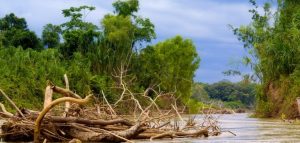When It Comes to Natural Climate Solutions, We Have an Unexpected Ally: The Water Sector

17 Sept 2018 | The Global Climate Action Summit wrapped up in San Francisco last week, and what a week it was. A coalition of nine foundations announced commitments totaling $459 million to conserve forests around the world and recognize the land rights of the indigenous and traditional communities who manage them. California released the groundwork for mobilizing major investments in reducing tropical deforestation through its carbon cap-and-trade program. And on Tuesday, the Governor’s Climate and Forests Task Force (GCF) officially and unanimously endorsed principles for collaboration with indigenous and local communities on climate.
All of these pieces move us closer to comprehensively protecting our forests, farms, and fields, which are land-based carbon sinks that can get us 37 percent of the way to meeting the Paris Agreement targets.
Of course, forests do more than just sequester carbon. They also regulate and purify water, which is why Forest Trends has been driving the agenda to restore “natural infrastructure” such as forests, grasslands, and wetlands, as a critical approach to ensuring water and sanitation for all.
The wonderful thing about natural infrastructure is that it is inherently multifunctional. The same nature-based interventions that help secure water supplies and improve water quality also provide critical benefits for climate mitigation and adaptation. Restoring forests or improving agricultural practices to manage erosion and other threats to drinking water quality sequesters carbon, provides buffers against flooding and sea level rise, and help to ensure food security and resilient livelihoods. And as suggested by the commitments we saw last week at GCAS, healthy natural systems are also the seat of tremendous cultural and spiritual wisdom and a source of sustainable livelihoods.
One country that already takes this relationship between nature and security seriously is Peru, where we are seeing an unprecedented commitment at the national level to invest in natural infrastructure for water and climate security. Already, more than $125 million has been allocated by public water companies in Peru for climate resilience and nature-based water security projects like replanting forests or rebuilding ancient pre-Incan canals high in the Andes that collect water and funnel it underground, so that it emerges to replenish rivers feeding cities like Lima, months later and hundreds of kilometers away. Lima’s water utility SEDAPAL, which with a customer base of 11 million people is Peru’s largest water utility, has already announced it will allocate more than $23 million from user tariffs to natural infrastructure for water, the most significant commitment made to date by any Latin American water service provider.
Now, Forest Trends is leading a consortium of partners including CONDESAN, the Peruvian Society for Environmental Law (SPDA), EcoDecision, and Imperial College London, backed by a $27.5 million commitment from USAID and the Government of Canada, that seeks to support Peru’s rapid scale-up of natural infrastructure for water security and climate across the country.
These water-driven investments will also generate benefits for climate mitigation and adaptation. We are excited by the potential in Peru to explore new pathways for mainstreaming more large scale investments in forests and sustainable land use from an unusual source: the water sector. Globally, we are poised to spend trillions to repair and expand the world’s existing water infrastructure in the coming decade. Approaches that link climate and water benefits within existing natural infrastructure investments by the water sector can expand the pool of investors and align climate mitigation, adaptation, and water security objectives for greater impact on the landscape.
Join us as we build the bridges to broader investment into forests and other natural ecosystems – maximizing the climate benefits of water management and the water benefits of climate action.
Please see our Reprint Guidelines for details on republishing our articles.

